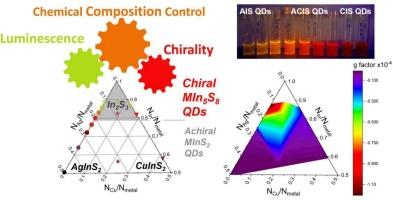Chiral multinary quantum dots through composition control: Toward next-generation semiconductor nanomaterials
IF 9.7
1区 化学
Q1 CHEMISTRY, PHYSICAL
引用次数: 0
Abstract
Chirality is a fundamental property of matter with far-reaching implications in chemistry, biology, and materials science. The emergence of chirality in inorganic nanomaterials has attracted growing attention due to both its fundamental significance for the design of novel nanostructures with unprecedented control on morphology and properties, as well as for its intrinsic potential in advanced applications. Herein, we report a novel strategy for the design of chiral nanomaterials by exploiting the precise tuning of the chemical composition of the nanocrystal. In this way, we successfully optimized the chiroptical activity in a broad compositional space of ternary and quaternary I-III-VI quantum dots (QDs) based on silver, copper, and indium sulfides. Our research reveals a clear threshold for chirality in relation to the chemical composition of the luminescent multinary nanocrystals. In particular, the magnitude of the chiroptical activity is directly related to the trivalent indium content, and only QDs produced in the compositional space of the indium-rich MIn₅S₈ phases (M = Ag, Cu) exhibit chiroptical activity, whereas the indium-poor MInS₂ counterparts remain consistently achiral. This compositional control of chirality arises from the distinct surface coordination environments, which govern the binding affinity and orientation of the chiral ligands on the QDs' surface, as demonstrated by computational studies. These findings establish a detailed mechanism for chirality induction in excitonic semiconductor nanomaterials and offer new design strategies for engineering chiral QDs through targeted control of their composition and surface chemistry.

通过成分控制的手性多量子点:迈向下一代半导体纳米材料
手性是物质的基本性质,在化学、生物学和材料科学中具有深远的意义。无机纳米材料中手性的出现引起了越来越多的关注,因为它对设计具有前所未有的形态和性能控制的新型纳米结构具有重要意义,以及它在高级应用中的内在潜力。在此,我们报告了一种通过利用纳米晶体化学成分的精确调谐来设计手性纳米材料的新策略。通过这种方法,我们成功地优化了基于银、铜和硫化铟的三元和四元I-III-VI量子点(QDs)在广阔的组成空间中的热效应活性。我们的研究揭示了与发光多纳米晶体的化学组成有关的手性的明确阈值。特别是,热合活性的大小与三价铟含量直接相关,只有在富铟的MIn₅S₈相(M = Ag, Cu)的组成空间中产生的量子点才表现出热合活性,而贫铟的MIn₂对应物始终保持非手性。计算研究表明,这种手性的组成控制来自于不同的表面配位环境,这些配位环境控制着量子点表面上手性配体的结合亲和力和取向。这些发现建立了激子半导体纳米材料手性诱导的详细机制,并通过有针对性地控制其组成和表面化学,为工程手性量子点的设计提供了新的策略。
本文章由计算机程序翻译,如有差异,请以英文原文为准。
求助全文
约1分钟内获得全文
求助全文
来源期刊
CiteScore
16.10
自引率
7.10%
发文量
2568
审稿时长
2 months
期刊介绍:
The Journal of Colloid and Interface Science publishes original research findings on the fundamental principles of colloid and interface science, as well as innovative applications in various fields. The criteria for publication include impact, quality, novelty, and originality.
Emphasis:
The journal emphasizes fundamental scientific innovation within the following categories:
A.Colloidal Materials and Nanomaterials
B.Soft Colloidal and Self-Assembly Systems
C.Adsorption, Catalysis, and Electrochemistry
D.Interfacial Processes, Capillarity, and Wetting
E.Biomaterials and Nanomedicine
F.Energy Conversion and Storage, and Environmental Technologies

 求助内容:
求助内容: 应助结果提醒方式:
应助结果提醒方式:


